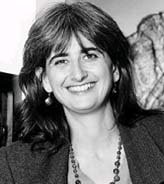Elisabeth Fischer Targ, M.D. (1961 - 2002) was a psychiatrist with many interests including psychic phenomena and the role of spirituality in health and healing. She earned her undergraduate and medical degrees at Stanford University. In one of her studies, she found that group therapy was as useful as Prozac for fighting depression. She is probably best known for her study on the effects of prayer on outcomes of men with AIDS. This randomized, double-blind study which was published in the Western Journal of Medicine found that the men who were prayed for had significantly better health and lower morbidity than the patients who did not receive the healing prayers. Elisabeth was the daughter of physicist Russell Targ, and the niece of champion chess player Bobby Fischer.
The life of psychiatrist Elisabeth Targ was haunted by coincidences. In 1972 her father, Russell Targ, cofounded the Stanford Research Institute to investigate psychic phenomena. Elisabeth participated in his ESP experiments, and he encouraged her to “remotely view” her birthday presents before she opened them (and claims she was correct most of the time). Elisabeth Targ was an academic superstar. She graduated from high school at age 15, was fluent in Russian, German and French, and eventually graduated from Stanford Medical School.
In July of 1998, Targ and colleagues at California Pacific Medical Center in San Francisco published a double-blind study in the Western Journal of Medicine that rocketed her to fame in the field of complementary and alternative medicine: Forty healers around the U.S. were recruited to pray for the health of patients with advanced AIDS. The prayed-for group had significantly fewer opportunistic illnesses than the control group, and Targ instantly became the poster child for a fledgling new field exploring prayer and healing. “Elisabeth is our hero,” wrote Mitchell Krucoff, a Duke University Medical Center cardiologist who has pioneered complementary therapies in patients with heart disease.
Targ’s research was impressive enough that in January of 2002 the National Institutes of Health gave her $1.5 million to carry out two more distant prayer studies, one on AIDS and another on glioblastoma multiforme, an aggressive and almost inevitably fatal brain tumor. In Europe and the U.S. there are approximately two to three new cases per 100,000 people annually.
Two months later, in March of 2002, a high-resolution MRI revealed that she suffered from a rapidly growing grade 4 glioblastoma multiforme brain tumor. Word of the horrific diagnosis spread, and healers began calling, visiting and praying from a distance–in a truly eerie echo of her newly funded study. Sadly, Elisabeth Targ died on July 18, 2002, at 11:11 p.m., 111 days after her diagnosis.
